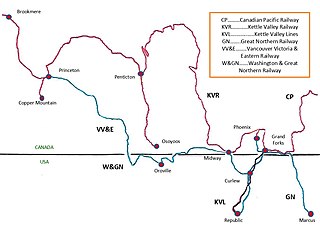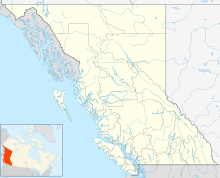
Swansea is a ghost town in La Paz County in the U.S. state of Arizona. It was settled circa 1909 in what was then the Arizona Territory. It served as a mining town as well as a location for processing and smelting the copper ore taken from the nearby mines.

Rossland is in the West Kootenay region of south central British Columbia. High in the Monashee Mountains, the city lies immediately east of the intersections of BC highways 3B and 22. The facilities provide a winter base for the nearby multi-peak ski hills of the Red Mountain Resort. In the non-winter months Rossland is frequented by mountain bikers, with golf and fishing options nearby as well.

The Kaslo and Slocan Railway (K&S) is a historic railway that operated in the West Kootenay region of southeastern British Columbia. The K&S connected Kaslo and Sandon. Initially a narrow-gauge railway, the line was later rebuilt to standard gauge.
The Nakusp and Slocan Railway (N&S) is a historic Canadian railway that operated in the West Kootenay region of southeastern British Columbia. The N&S initially connected Nakusp and Three Forks but soon extended to Sandon.
Anyox was a small company-owned mining town in British Columbia, Canada. Today it is a ghost town, abandoned and largely destroyed. It is located on the shores of Granby Bay in coastal Observatory Inlet, about 60 kilometres southeast of Stewart, British Columbia, and about 20 kilometres, across wilderness, east of the tip of the Alaska Panhandle.
Hedley is an unincorporated community near the mouth of Hedley Creek in the Similkameen region of southern British Columbia. The former mining town, on BC Highway 3, is by road about 74 kilometres (46 mi) southwest of Penticton and 38 kilometres (24 mi) southeast of Princeton.
Eholt is in the Boundary Country region of south central British Columbia. This ghost town, on BC Highway 3, is by road about 27 kilometres (17 mi) northwest of Grand Forks and 14 kilometres (9 mi) northeast of Greenwood.
Mount Sicker is in southern Vancouver Island, British Columbia. The twin summits of Big Sicker Mountain, at 716 metres (2,349 ft), and Little Sicker Mountain, at 660 metres (2,170 ft), are near Crofton, Chemainus and Duncan.
Mascot Mine of Hedley was a gold mine on Nickel Plate Mountain at Hedley in the Similkameen region of southern British Columbia.
Copper Mountain was an important copper-mining company town in the Similkameen Country of the Southern Interior of British Columbia, Canada, just south of the town of Princeton.

Phoenix is a ghost town in the Boundary Country of British Columbia, Canada, 11 km east of Greenwood. Once called the “highest city in Canada” by its citizens it was a booming copper mining community from the late 1890s until 1919. In its heyday it was home to 1,000 citizens and had an opera house, twenty hotels, a brewery and its own city hall. Phoenix’s magistrate, Judge Willie Williams, who served there from 1897 until 1913, became famous for his booming declaration, “I am the highest judge, in the highest court, in the highest city in Canada.” In 1911, Phoenix’s hockey team won the provincial championship and asked for the right to compete for the Stanley Cup, but it was too late to qualify. The Granby Consolidated Mining, Smelting and Power Company operated the Phoenix Mine, a copper mine that produced 13,678,901 tons of ore before operations ceased on June 14, 1919.
Phoenix Mine was an open pit and underground mining operation in city of Phoenix in the Boundary Country region of British Columbia, Canada that operated in the early and mid 20th century, run by the Granby Consolidated Mining, Smelting and Power Company. It was discovered in 1891, but was a lower grade copper deposit than the Rossland and Slocan deposits. The low grade and the nearest railroad being 75 miles (121 km) resulted in the Phoenix receiving less attention.
Anaconda is an unincorporated community south of the confluence of Eholt and Boundary creeks in the Boundary Country region of south central British Columbia. About 43 kilometres (27 mi) west of Grand Forks, and 82 kilometres (51 mi) east of Osoyoos, on Highway 3, the neighbourhood is immediately south of Greenwood.
Volcanic City was on the east side of the Granby River, near Volcanic Creek, in the Boundary region of south central British Columbia. The ghost town is by road about 18 kilometres (11 mi) north of Grand Forks via North Fork Rd.
Zincton is a ghost town in the West Kootenay region of southeastern British Columbia. This former mining community, on BC Highway 31A, is by road about 15 kilometres (9 mi) northeast of New Denver and 31 kilometres (19 mi) northwest of Kaslo.

The Highland Valley Copper mine is the largest open-pit copper mine in Canada, located near Logan Lake, British Columbia. It is an amalgamation of three historic mining operations: Bethlehem, Lornex and Highmont.

The Vancouver, Victoria and Eastern Railway (VV&E) was a railway line proposed to connect Metro Vancouver with the Kootenays, in Canada. After acquisition by the Great Northern Railway (GN), most of the route was built, but a through service, using the arranged running rights on the tracks of other companies, never eventuated.
The Spokane Falls & Northern (SF&N) is a historic railroad that operated in northeast Washington state. The SF&N initially connected the city of Spokane with the Canada–United States border at Waneta, British Columbia.
Nickel Plate Mine was a gold mine on Nickel Plate Mountain at Hedley in the Similkameen region of southern British Columbia.






